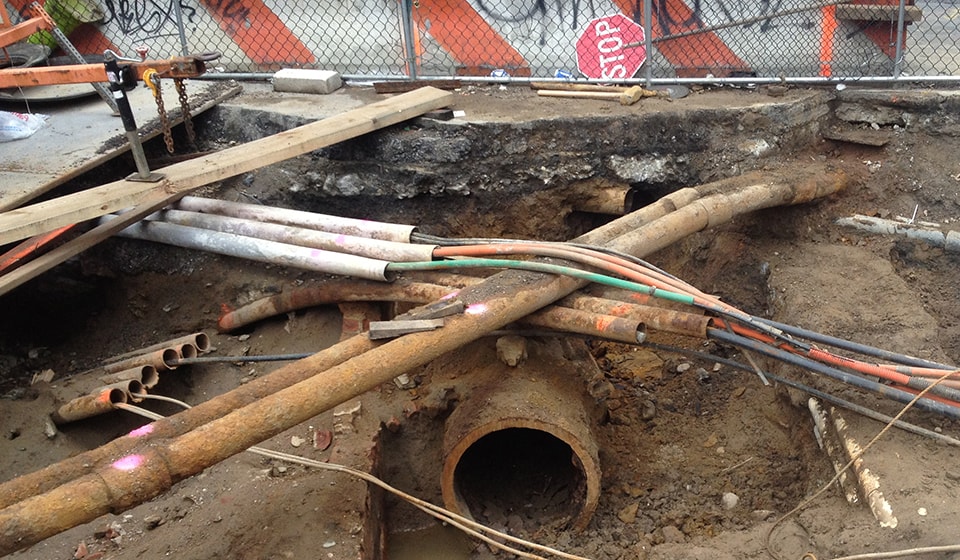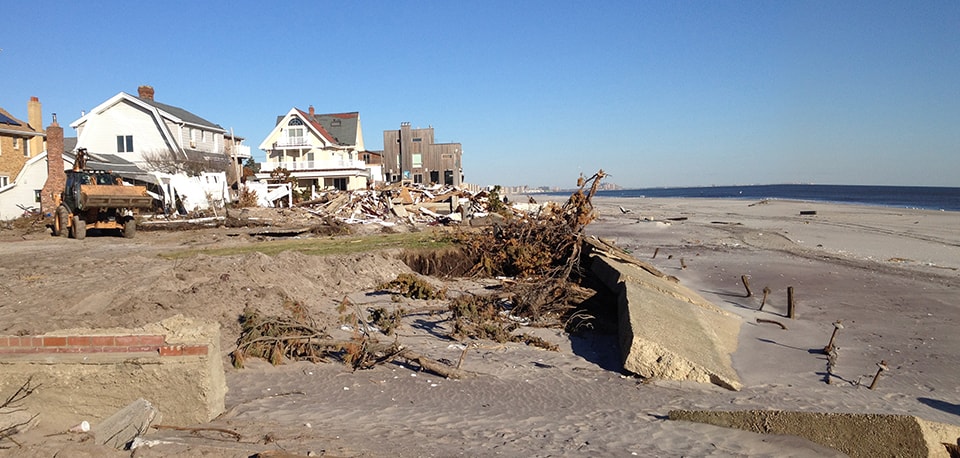Infrastructure as Urbanism
In architecture, landscape architecture, ecology, economics, and even politics, we have recently seen the emergence of “infrastructure” as a central concept within the larger conversation about urbanism. Interest in urbanism has been growing over the last few decades alongside the realization of cities’ economic power and both the epic challenges and game-changing opportunities of the global migration to urban centers. The most difficult questions of urban performance, however, are often inseparable from the functioning and design of urban infrastructure.
Long focused on prominent civic objects and spaces in cities, designers are increasingly turning their attention to the less visible, but indispensible systems that underlie urban fabric. As designers expand the scale and scope of their projects, they are also recognizing the potential of infrastructure to serve as fertile conceptual territory. Unlike individual buildings (with the exception of megastructures), infrastructure can be seen as a tangible structuring device that operates at the scale of the city. In embracing infrastructure, designers are extending their agency to look not just at the pieces and parts of the city, but at the design of entire systems and their operations. Infrastructure is also a civic project, and as such just as worthy of design consideration as the vernacular urban fabric and territory to which it gives structure. Finally, amid an accelerating cascade of small failures and several highly visible catastrophic collapses, the value of often-overlooked infrastructural systems is becoming more evident, sparking a perception of infrastructural crisis and finally getting some overdue attention [1].
More importantly for us, however, is the ability of infrastructure to offer a framework for asking larger questions about competing visions of urban structure and performance: about the relationship of a designed intervention to its surrounding biophysical flows; about the connection between a system, its context and constituents; about the role of social and economic forces in shaping urban life.
Photo by Nicholas Pevzner
Emerging Conversations
Over the last several years, we have seen a number of architectural events and publications focused on infrastructure and exploring the role of design in finding new solutions for complex and technical infrastructural challenges while empowering architects and landscape architects to ask infrastructural questions. For example, the WPA 2.0 competition in 2009, organized by UCLA’s CityLAB as a response to the US Recovery Act, prompted designers “to envision a new legacy of publicly-supported infrastructure, projects that explore the value of infrastructure not only as an engineering endeavor but as a robust design opportunity to strengthen communities and revitalize cities” [2]. MoMA’s Rising Currents: Projects for the New York Waterfront exhibition in 2010, invited interdisciplinary teams to take on the challenge of sea-level rise in New York Harbor and to, “imagine new ways to occupy the harbor itself with adaptive “soft” infrastructures… that change our relationship to one of the city’s great open spaces” [3].
The Landscape Infrastructure Symposium at the Harvard GSD in 2012, invited a group of architects, landscape architects, historians, engineers, and ecologists to explore ”the future of infrastructure and urbanization beyond the dogma of civil engineering and transportation planning” and “to propose responsive strategies that address the predominant challenges facing urban economies today” [4]. Additionally, picking up on a growing public discourse on infrastructure and reacting, often directly, to recent infrastructure failures, climate-related catastrophes and the continued failure of infrastructural systems to meet the needs of present populations, many design schools have conducted studios and seminars focused on infrastructure.
Infrastructure is certainly a topic of the day; in his 2013 State of the Union address, President Obama singled out infrastructure as a critical weakness and impediment to re-growing the US economy. Obama referenced 70,000 structurally deficient bridges across the US, and proposed an Infrastructure Bank that would seek private money to supplement public spending on ports, pipelines, roads, bridges, airports, high-speed rail, and self-healing power grids [5].
Every four years, the American Society of Civil Engineers is tasked with evaluating the current condition and performance of the nation’s infrastructure. This year, they gave the country a D+ rating (up from a D rating in 2009) and estimated a need for $3.6 trillion in investments over the next seven years [6].
In the wake of superstorm Sandy, which made highly visible the infrastructural fragility of the New York metropolitan area and the New Jersey shoreline, the simmering conversation about the infrastructure of coastal defense and urban resilience has boiled over, reaching a visibility not seen since the days after Katrina. Along the eastern seaboard, serious debates between proponents and opponents of “hard” engineered defenses are ongoing, representing a kind of proxy war between traditional engineering approaches and an emerging alliance of advocates for more flexible and responsive, though mostly still untested, “soft” systems.
Aftermath of Superstorm Sandy, Rockaways. Photo by Nicholas Pevzner
From Landscape Urbanism to Landscape Infrastructure
In many ways, landscape infrastructure builds on the theoretical ground pioneered by landscape urbanism. Early theorists of landscape urbanism were interested in describing the city as a landscape, overcoming the binary between urban and rural (and urban and natural) that reigned at the time [7,8].
Drawing from narratives of cultural and political geography, these writers were interested in reexamining the physical parts that make up a city, along with all the related components scattered across the horizontal urban field (blocks, buildings, parks, watersheds, foodsheds, and habitats to name just a few). They were also concerned with the social and economic drivers at play in the urban landscape [9,10].
Whereas landscape urbanism looked to open conversations with developers, planners and policy makers in order to give landscape a role in shaping urban growth, landscape infrastructure attempts to bring civil engineers, highway departments, international shippers, the US Army Corps of Engineers, and similarly massive players on the national and global stage into the game.
Filled mangrove near Bandra Station, Mumbai. Photo by Stephanie Carlisle
The Essays
Despite all the newfound attention, the definition of infrastructure is still very much in flux. Scenario 3: Rethinking Infrastructure brings together a group of pieces that take on the design of infrastructure from a number of scales and disciplinary perspectives. This issue highlights how practitioners and theorists are expanding the definition of infrastructure, analyzing its component parts, and proposing new kinds of infrastructure projects.
In his essay The Humanity of Infrastructure: Landscape as Operative Ground, Dane Carlson looks beyond the discrete infrastructural objects that underlie contemporary cities and their peripheries, so as to recontexualize the landscape itself as the infrastructure for human inhabitation. Even pre-industrial landscapes have long operated infrastructurally from a biophysical perspective, he argues, and people have long merged constructed elements with natural functions.
Meg Studer’s project NaCl: Operations Enabling Emptiness explores the systems and networks of exchanges by which millions of tons of road salt transform the roadways of the Northeast corridor, mapping the flows of a vast anthropogenic material infrastructure and tracing the unexpected causal relationships that link landscapes of extraction, distribution, commerce and consumption.
In Feedback: Designing the Dredge Cycle, Rob Holms and Brett Milligan examine the implications of another set of anthropogenic and logistical landscapes, describing the sedimentary infrastructure that links the degradation of costal landscapes, the expansion of international shipping networks, the development of coastal communities and the creation of new, constructed landscapes. They recast dredge material as both an inevitable byproduct of global market forces, but also an exciting, albeit challenging, material for a whole new genre of coastal landscapes.
Michael Ezban’s Aqueous Ecologies proposes the integration of a closed-loop aquaculture system with local development, imaging the economic and cultural synergies between productive landscapes, wastewater treatment and urban development that enhance surrounding natural ecosystems.
Applying the idea of synthetic landscape infrastructure systems to a city in which typologies of infrastructure-supported dense development have proved unsustainable, Jill Desimini, in her essay, Wild Innovation: Stoss in Detroit, offers an alternative model of design and decision-making, in which zoning, regulations, productive landscapes, and blue- and green infrastructure are all combined into a strategic landscape planning process.
Scott Muller explores the role of markets and community actors further in his piece, The Next Generation of Infrastructure, arguing that in an unstable global investment climate, we need to focus much more on the process by which cities and societies make decisions about large infrastructure projects, and on growing an effective social infrastructure that can empower citizens and policymakers to put their cities on the correct decision pathways.
In Contemporary Infrastructure, an interview with Ksenia Kagner, Marcel Smets talks about the importance of design investment in the public realm for constructing high-value urban areas, why transportation projects are particularly compelling areas of investment by government, and about how to get designers more integrated into the decision-making process that produces infrastructure.
Margie Ruddick’s Queens Plaza project offers a critique of the traffic-first approach to city streets, and provides an example of landscape architecture offering both a transportation design and a high-performing public space solution.
In Skeleton Forms: The Architecture of Infrastructure, Laila Seewang looks at how applying architectural parameters to a city’s infrastructural objects — by focusing on boundary, form, and symbolism — a historical reading can emerge that captures the interplay of forces that have driven that city’s development.
In Made in Australia: The Future of Australian Cities, Richard Weller and Julian Bolleter grapple with the pressure of accommodating the rapid growth of Australia’s urban population. The authors argue for the need to rethink local settlement patterns that encourage sprawl, and put in place megaregional infrastructure projects capable of steering growth trajectories and of supporting the development of new high-quality, liveable cities.
Laura Solano zooms in to focus on the constructed nature of urban soil. Her essay, Reconsidering the Underworld of Urban Soils, points to the many ways in which the quality and treatment of soil on a site determine the success or failure of urban landscape projects, and all the urbanistic goals that rest on them; in her view, soil is the microscopic infrastructure for the performance of the city above.
In his essay From Landscaping to Infrastructure: The Scope and Agency of Maintenance, Michael Geffel presents the often-overlooked processes of landscape maintenance as a design opportunity, whether at the scale of the lawn, the power-line corridor, or massive coastal dune creation. If considered as an infrastructural service underlying entire landscape systems, he argues, the redesign of maintenance regimes offers designers a tool for effecting change at a vast scale.
In Yangtze River Delta Project, Catherine Seavitt examines the infrastructure of coastal defense in Shanghai, noting the increasing pressures on hard-engineered coastal protections from changing weather and rising seas, and proposes an adaptive, resilient landscape-based approach to flood protection.
In Productive Filtration: Living Systems Infrastructure in Calcutta, Stephanie Carlisle uses the case study of a sewage-fed aquaculture wetland that developed over a century of local experimentation and negotiation. The piece uses dynamic system modeling to explore the interconnected biological, social and economic components that balance the wetland’s multiple functions, allowing for the testing of future development scenarios.
The pieces represented in this collection have all grappled with the pressing question of how infrastructure of the next century will be imagined and built. We hope that you enjoy this issue of Scenario Journal and that you find it useful in expanding the dialogue on the creative and critical potential of infrastructure in your own work.
Stephanie Carlisle is a designer and environmental researcher whose work focuses on the relationship between the built and natural environment. She works in the research group at KieranTimberlake Architects. She is a co-editor of this issue.
Nicholas Pevzner’s work explores the role that infrastructural landscape moves can play in structuring and sustaining healthy cities. He teaches in the Department of Landscape Architecture and Regional Planning at the University of Pennsylvania School of Design. He is a co-editor of this issue.
Refrences
[1] Pierre Bélanger, “Redefining Infrastructure,” in Ecological Urbanism, ed. Mohsen Mostafavi and Gareth Doherty [Baden, Switzerland: lars Muller Publishers, 2010], 341-344.
[2] “About WPA 2.0,” accessed May 20, 2013, http://wpa2.aud.ucla.edu/info/index.php?/about/about/.
[3] “Exhibitions: Rising Currents: Projects for New York’s Waterfront,” MoMA. Updated March 22, 2010, accessed on May 22, 2013, http://www.moma.org/visit/calendar/exhibitions/1031.
[4] “Events: Landscape Infrastructure Symposium,” Harvard Graduate School of Design, March 23-24, 2012 accessed at http://www.gsd.harvard.edu/#/events/landscape-infrastructure.html.
[5] “Remarks by the President in the State of the Union Address,” transcript of the President’s speech, Office of the Press Secretary, February 12, 2013. Accessed at http://www.whitehouse.gov/the-press-office/2013/02/12/remarks-president-state-union-address.
[6] American Society of Civil Engineers, “2013 Report Card for America’s Infrastructure” (Report, ASCE, 2013) accessible in full at http://www.infrastructurereportcard.org/a/#p/home.
[7] James Corner, “Ecology and landscape as agents of creativity” in Ecological design and planning (1997): 80-108.
[8] James Corner, ed., Recovering Landscape (New York: Princeton Architectural Press, 1999)
[9] Ibid.
[10] Charles Waldheim, ed., The Landscape Urbanism Reader (New York: Princeton Architectural Press, 2006)





